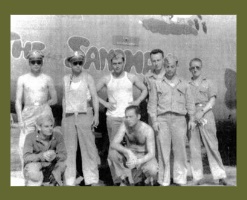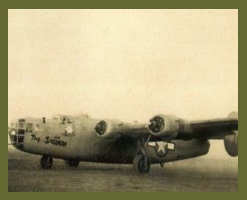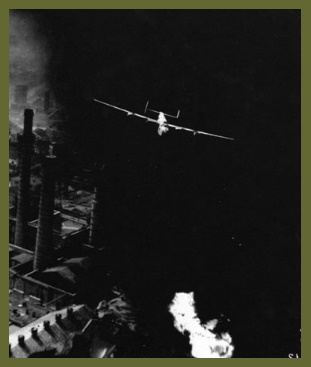::Major Robert W. Sternfels - Sandman
January 1942 landed me at Kelly Field, Texas and by September of 1942 I accumulated close to 400 hours of flying and graduated as a second lieutenant. First post graduate assignment was training in B17s . The largest bomber the US had at that time. It seemed
like a monster to most of us after flying small trainers but within a few flights I checked out as first pilot and remained that way all through my four years of active duty.
When the Air Corps needed B24 crews our class was selected to train in B24s at Tucson, Arizona and other fields. Finally the day arrived with my crew we picked up our B24 in Topeka, Kansans.. After a master sergeant gave us our plane number we walked down the ramp filled with olive drab B24s only to find our plane painted in a terrible shade of beige. We thought it was just an undercoat but it turns out to be the shade of pink beige that matched the sand of the desert.
In about a month of jumping from one foreign air base to another with the crew of 10 managing to stay healthy for less than half of the time, we finally arrived at a horrible
 looking base near the burned out completely destroyed town of Benghazi, Libya. This was almost half way around the world and for 10 city boys Benghazi was not what we pictured as our base. However, it was early in the war and North Africa had just been won by the British.. The German Field Marshall Rommel left the very day that I landed at Benghazi. Question….does anyone believe he knew Sternfels and his crew with a pink B24 was coming to the battle the Germans?
Living on the desert is different. The terrain was nothing but sand and each day we had dust storms. You can picture what the very micro fine sand partials can do to the engines and mechanical parts of a plane but they also take a toll on one’s food and living quarters. We only had British tents and the sand got into everything.
Not more than a day or two we were starting to fly combat missions.
looking base near the burned out completely destroyed town of Benghazi, Libya. This was almost half way around the world and for 10 city boys Benghazi was not what we pictured as our base. However, it was early in the war and North Africa had just been won by the British.. The German Field Marshall Rommel left the very day that I landed at Benghazi. Question….does anyone believe he knew Sternfels and his crew with a pink B24 was coming to the battle the Germans?
Living on the desert is different. The terrain was nothing but sand and each day we had dust storms. You can picture what the very micro fine sand partials can do to the engines and mechanical parts of a plane but they also take a toll on one’s food and living quarters. We only had British tents and the sand got into everything.
Not more than a day or two we were starting to fly combat missions.
It took just two before they checked me out to fly my crew in the plane I took over and was named The Sandman. By July I had made close to 18 missions and in the middle of
 July of 1943 a Colonel Jake Smart asked to fly with me on a mission thus was the start of an association that lasted to this day. It turns out he was the Air Corp’s planner of the Low Level Ploesti Mission which was to occur on August 1st, 1943.
As I mentioned people do remember outstanding events in their lives and one was about
to happen to me. The Low Level Ploesti was the roughest mission I ever made. Flying formation some 14 hours and 20 minutes in enemy territory without fighter protection, none was possible at that time in the war, was not only nerve racking but very strenuous.
B24s are not easy to fly and most difficult in formation. However, the plan to bomb the
Oil refineries of Ploesti, Romania were every allied country’s priority. Germany was using the Ploesti oil refineries as their main source for supplying fuel for their navy, ground forces and air force. Without the oil from Ploesti, Germany could not maintain their early advantage so the destruction of the oil refineries at Ploesti was priority # 1 for the allies.
July of 1943 a Colonel Jake Smart asked to fly with me on a mission thus was the start of an association that lasted to this day. It turns out he was the Air Corp’s planner of the Low Level Ploesti Mission which was to occur on August 1st, 1943.
As I mentioned people do remember outstanding events in their lives and one was about
to happen to me. The Low Level Ploesti was the roughest mission I ever made. Flying formation some 14 hours and 20 minutes in enemy territory without fighter protection, none was possible at that time in the war, was not only nerve racking but very strenuous.
B24s are not easy to fly and most difficult in formation. However, the plan to bomb the
Oil refineries of Ploesti, Romania were every allied country’s priority. Germany was using the Ploesti oil refineries as their main source for supplying fuel for their navy, ground forces and air force. Without the oil from Ploesti, Germany could not maintain their early advantage so the destruction of the oil refineries at Ploesti was priority # 1 for the allies.
On August 1st 1943 178 B24s took off from bases around Benghazi, Libya headed for the small town of Ploesti. A number of problems began to occur and by the time I reached the outskirts of Ploesti., our numbers had been reduced to 165 B24s. But what lay ahead was a horrible engagement with the German defenses.
We made a turn at a town 25 miles North of Ploesti and were using a railroad track to guide us into the target but after we leveled out from the turn a gun train with a bout 15 flat cars began firing at the B24s which were just 150 feet above the ground. With every type of gun from 20 mm to 88mm cannons the Germans were knocking down the B24s like hitting ducks in a shooting gallery. I was lucky not to have been hit but out of our group almost 40 percent of the planes were lost.
After passing the gun or flak train we viewed our target - it was burning.
At 150 to 200 feet the flames from the fire reached the planes but the real difficulty was created by our own planes in the form of prop wash. It was almost impossible to fly any form of formation and it took both the pilot and co-pilot to hold the plane from crashing. Then after we dropped the bombs our troubles were not over. I saw a shinning cable directly ahead, the silky oil smoke silhouetted the cable.. I knew if it hit the nose of the plane, the two guys up front might not survive so I banked the plane to the left just enough so the cable was caught by the number 3 propeller.
We heard noises similar to a couple of loud shots from a cannon being fired and then
 complete silence. I checked all controls took a quick look at the engine instruments but all seemed normal so I concentrated on flying in and out of the oil smoke. Our bombs were dropped on schedule so now we were ready to return to our base.
complete silence. I checked all controls took a quick look at the engine instruments but all seemed normal so I concentrated on flying in and out of the oil smoke. Our bombs were dropped on schedule so now we were ready to return to our base.
When leaving the smoke for clear air I saw three smoke stacks on my right, these were higher than my plane and I was headed directly for them. With another slight bank to my left we missed the stacks but later after looking at a photo taken at just the same moment, we calculated that we missed the oil refinery stacks by just 65 feet.
The day was not over. Over our radio we were instructed to form on our group commander’s plane. Looking ahead I could see him as he was flying much slower due to an engine being out of commission. Later that night after flying some 7 hours over enemy territory, mountains and some unfriendly Germans with anti aircraft cannons, we landed at the island of Cyprus. Actually three of the B24s that escorted the CO of our group landed without a problem. However our CO crashed as he was slightly low and hit short of the runway washing out the landing gear.
No one was hurt but the plane was a complete loss. The next day we headed for Palestine and a day later I flew the CO back to Benghazi. We had flown over 3,000 miles on this mission.
The experience of that one mission still remains in my memory to this day. My book that recalls all the true facts of the Low Level Ploesti is far from fiction as it tells the story of how the mission really happened. Many authors try to develop stories that add suspense to their script but in my book I researched facts from those who were on the mission.
This included the man who planned the mission for the Air Corps as well as the Colonel who was the leader of the mission. Many Air Force historians feel my book is the very best ever published about the Ploesti Mission. It’s called Burning Hitler’s Black Gold.